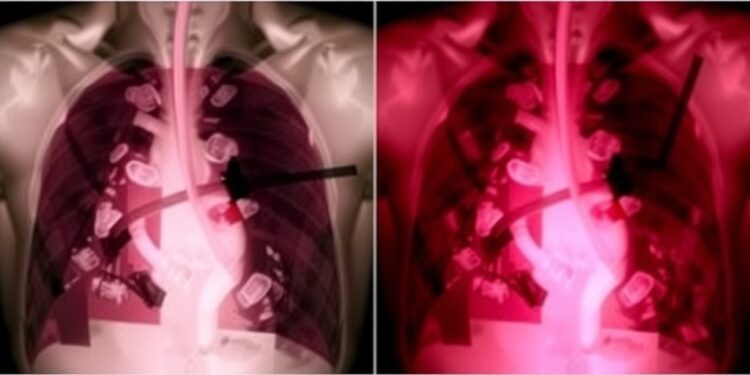In the realm of thoracic surgery, the modalities of postoperative care are continuously evolving to improve patient outcomes. One recent study sheds light on the comparative efficacy of two prevalent types of chest drains following video-assisted thoracoscopic surgery (VATS) lobectomy. This investigation juxtaposed the coaxial silicone (SIL) drains against the traditional polyvinyl chloride (PVC) drains, focusing particularly on their impact on postoperative pain, drainage efficacy, and overall treatment results within a defined timeframe.
Chest drains are commonly utilized in thoracic surgery to facilitate the evacuation of fluid and air from the pleural space post-surgery. The choice of drain can significantly influence a patient’s postoperative experience, encompassing pain management and recovery speed. This randomized prospective study comprised a total of 80 patients, all diagnosed with lung cancer, who underwent VATS lobectomy between September 2020 and June 2023. A meticulous randomization process ensured that participants were divided equally into two groups, thereby allowing for an equitable comparison of the two drain types.
In the methodology, the aim was to rigorously evaluate pain levels over the initial postoperative days. This evaluation was conducted through several metrics: analgesic consumption, respiratory muscle strength, and pain intensity as gauged by the visual analog scale (VAS). These parameters were critically assessed both at rest and during periods of physical activity, thus providing a comprehensive understanding of the patients’ pain experiences.
Interestingly, the study’s findings were revealing. Out of the original number of participants, 69 patients were deemed appropriate for final analysis — 35 individuals in the experimental group utilizing SIL drains and 34 individuals using PVC drains. The comparative analysis detailed that, although there were no statistically significant differences in drainage efficacy or short-term treatment outcomes between the two groups, the pain experience notably favored the SIL drains. Patients in the experimental cohort exhibited a marked reduction in pain levels, enhancing their postoperative comfort.
Pain management is a critical component of postoperative care and, in this study, a significant reduction in the consumption of analgesics was observed among the SIL drain users. Specifically, the use of Diclofenac was found to be significantly lower in the experimental group, boasting a p-value of 0.004; this suggests that the softer material of SIL drains may inherently lessen pain and discomfort in postoperative settings. The data showed a positive trend regarding the consumption of other analgesics as well, implying a potential paradigm shift in pain management techniques post-surgery.
In addition to pain metrics, respiratory muscle strength was another critical area of focus. Results illustrated that all measured parameters of respiratory function were higher in the group using SIL drains. Notably, static maximal inspiratory pressure (MIP) on the second postoperative day yielded significant differences, as did both static and dynamic maximal expiratory pressure (MEP) on the first postoperative day. Such findings underscore the possibility that SIL drains may contribute to preserving respiratory function, which is crucial for recovery in patients undergoing lung resections.
This study also measured static visual analog scale (S-VAS) scores on the first postoperative day, revealing a statistically significant lower pain rating among those with SIL drains. Однако, dynamic VAS scores did not show comparable differences, suggesting that while the initial phase of recovery saw substantially improved comfort levels with SIL drains, the benefits might not be as pronounced during active movements or increased physical exertion.
The implications of these findings are enormous. The evidence suggests that soft, pliable materials utilized in coaxial SIL drains can significantly influence not only the pain levels experienced by patients but also potentially enhance their respiratory recovery in the days following surgery. These insights recommend a reevaluation of current practices regarding chest drain selection, advocating for the consideration of softer materials to optimize postoperative patient outcomes.
The necessity of effective pain management strategies is underscored by the growing body of research emphasizing acute pain relief as a cornerstone of patient care post-surgery. As surgeons and medical professionals continue to stress the importance of patient comfort during recovery, the results of this study provide valuable data that could inform future clinical decisions regarding chest drain usage.
Furthermore, these findings add to the existing literature already discussing the efficacy of silicone drains in improving patient care scenarios, solidifying the argument for their broader application in surgical settings. As surgical techniques, technologies, and materials evolve, it becomes imperative to integrate new research-based evidence into standard protocols, ensuring patients receive the highest quality of care possible.
Looking forward, this study paves the way for further research that could explore additional parameters such as long-term outcomes associated with different drain types, the psychological aspects of postoperative recovery, and broader patient quality-of-life assessments. With ongoing advancements in materials science and surgical techniques, these insights will undoubtedly foster enhanced recovery protocols that prioritize patient comfort and reduce the burden of postoperative pain in thoracic surgery.
In conclusion, the utilization of coaxial silicone drains represents a promising advancement in enhancing recovery experiences post-VATS lobectomy. As this field continues to progress, integrating such innovations into clinical practice could emerge as a standard, ultimately improving outcomes for countless patients facing lung surgical interventions.
Subject of Research: People
Article Title: Impact of chest tube type on pain, drainage efficacy, and short-term treatment outcome following video-assisted thoracoscopic surgery lobectomy: a randomized controlled trial comparing coaxial silicone drains and standard polyvinyl chloride drains
News Publication Date: 21-Feb-2025
Web References:
References:
Image Credits:
Keywords: Video-assisted thoracoscopic surgery (VATS); lobectomy; postoperative pain; chest tube; analgesia




